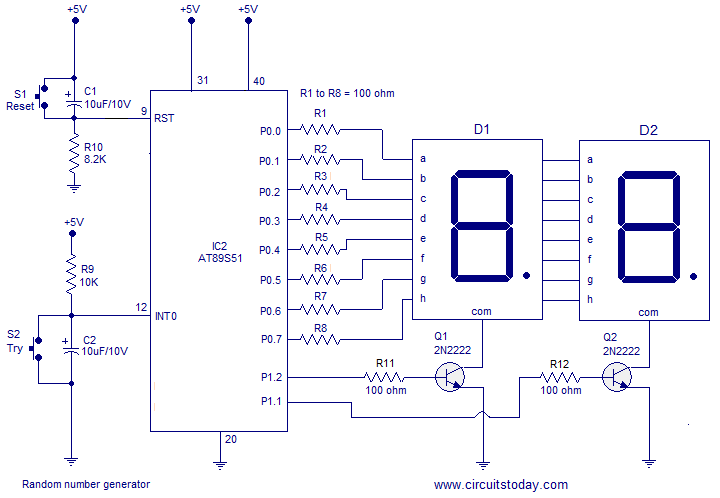Monday, April 8, 2013
Random number generator using 8051
between 0 & 99 is shown in this article. The circuit it self is very
simple and may not find any applications in serious embedded projects
and this article is just an illustration. The circuit is based on
AT89S51 microcontroller, two seven segment LED displays, two transistors
and few passive components.
Circuit diagram.

Random number generator using 8051
The
two seven segment LED displays are multiplexed together and their data
lines are connected to Port0 of the microcontroller. Transistors Q1
and Q2 drives the corresponding displays D1 and D2. The driving signals
for there transistors are obtained from P1.1 and P1.2. Push button
switch S1,capacitor C1 and resistor R10 forms a debouncing reset
circuit. Resistor R9, capacitor C2 and pushbutton switch S2 will
provide an active low harware interrupt signal at INTO (pin12) when
ever S2 is pressed. Here also R9 and C2 are meant for debouncing. After
power ON the display will show blank and when push button S2 is
pressed the display will show a random number between 0 and 99. For
another try you have to press the reset switch and then switch S2. If
you need a single digit setup only, the remove display D2 and
its associated components. Everything else is same.
two seven segment LED displays are multiplexed together and their data
lines are connected to Port0 of the microcontroller. Transistors Q1
and Q2 drives the corresponding displays D1 and D2. The driving signals
for there transistors are obtained from P1.1 and P1.2. Push button
switch S1,capacitor C1 and resistor R10 forms a debouncing reset
circuit. Resistor R9, capacitor C2 and pushbutton switch S2 will
provide an active low harware interrupt signal at INTO (pin12) when
ever S2 is pressed. Here also R9 and C2 are meant for debouncing. After
power ON the display will show blank and when push button S2 is
pressed the display will show a random number between 0 and 99. For
another try you have to press the reset switch and then switch S2. If
you need a single digit setup only, the remove display D2 and
its associated components. Everything else is same.
Program.
ORG 000H
SJMP MAIN
ORG 003H // sets the starting address for the ISR
ACALL ISR // calls the ISR subroutine when S2 is pressed
RETI // return from interrrupt
MAIN:SETB IP.0 // this part sets the initial conditions
SETB TCON.0
SETB IE.0
SETB IE.7
MOV P0,#00000000B
MOV P1,#00000000B
MOV DPTR,#LUT // moves the starting address of LUT to DPTR
LABEL:MOV R6,#99D // this part generates the random number
LOOP:MOV A,R6
DJNZ R6,LOOP
SJMP LABEL
ISR: MOV A,R6 // Subroutine ISR displays the current random number
MOV B,#10D
DIV AB
SETB P1.2
ACALL DISPLAY
MOV P0,A
ACALL DELAY
MOV A,B
CLR P1.2
SETB P1.1
ACALL DISPLAY
MOV P0,A
ACALL DELAY
CLR P1.1
SJMP ISR
RET
DELAY: MOV R3,#02H // this subroutine creates 1mS delay for switching the displays
DEL1: MOV R2,#0FAH
DEL2: DJNZ R2,DEL2
DJNZ R3,DEL1
RET
DISPLAY: MOVC A,@A+DPTR // produces the digit drive pattern for the current digit in A
RET
LUT: DB 3FH // Look up table
DB 06H
DB 5BH
DB 4FH
DB 66H
DB 6DH
DB 7DH
DB 07H
DB 7FH
DB 6FH
END
About the program.
The
first part of the program is the portion labelled MAIN which sets the
initial conditions and the interrupt parameters. The next part is the
loop named LABEL which loads 99D to register R6 then decrements it by 1
until 0 and then repeats the cycle again. This is the part which
generates the random number. Every time R6 is decremented the resultant
value is moved to accumulator A. Next part is the interrupt service
routine which is written as a subroutine named ISR. When ever there is
an interrupt at INT0 (push button S2 is pressed), the ISR is called.
The ISR perfoms necessary mathematical manipulations on the content of A
in order to split out the two digits and then proceeds to show it on
the display. Subroutine DELAY produces roughly 1ms delay for switching
the displays. Subroutine DISPLAY adds the current value in A with the
address stored in DPTR (starting address of LUT) and moves the target
content to A. The result will be the digit drive pattern for the
current digit in A.
first part of the program is the portion labelled MAIN which sets the
initial conditions and the interrupt parameters. The next part is the
loop named LABEL which loads 99D to register R6 then decrements it by 1
until 0 and then repeats the cycle again. This is the part which
generates the random number. Every time R6 is decremented the resultant
value is moved to accumulator A. Next part is the interrupt service
routine which is written as a subroutine named ISR. When ever there is
an interrupt at INT0 (push button S2 is pressed), the ISR is called.
The ISR perfoms necessary mathematical manipulations on the content of A
in order to split out the two digits and then proceeds to show it on
the display. Subroutine DELAY produces roughly 1ms delay for switching
the displays. Subroutine DISPLAY adds the current value in A with the
address stored in DPTR (starting address of LUT) and moves the target
content to A. The result will be the digit drive pattern for the
current digit in A.